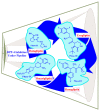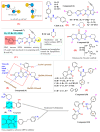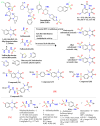Insight into Structure Activity Relationship of DPP-4 Inhibitors for Development of Antidiabetic Agents
- PMID: 37570832
- PMCID: PMC10420935
- DOI: 10.3390/molecules28155860
Insight into Structure Activity Relationship of DPP-4 Inhibitors for Development of Antidiabetic Agents
Abstract
This article sheds light on the various scaffolds that can be used in the designing and development of novel synthetic compounds to create DPP-4 inhibitors for the treatment of type 2 diabetes mellitus (T2DM). This review highlights a variety of scaffolds with high DPP-4 inhibition activity, such as pyrazolopyrimidine, tetrahydro pyridopyrimidine, uracil-based benzoic acid and esters, triazole-based, fluorophenyl-based, glycinamide, glycolamide, β-carbonyl 1,2,4-triazole, and quinazoline motifs. The article further explains that the potential of the compounds can be increased by substituting atoms such as fluorine, chlorine, and bromine. Docking of existing drugs like sitagliptin, saxagliptin, and vildagliptin was done using Maestro 12.5, and the interaction with specific residues was studied to gain a better understanding of the active sites of DPP-4. The structural activities of the various scaffolds against DPP-4 were further illustrated by their inhibitory concentration (IC50) values. Additionally, various synthesis schemes were developed to make several commercially available DPP4 inhibitors such as vildagliptin, sitagliptin and omarigliptin. In conclusion, the use of halogenated scaffolds for the development of DPP-4 inhibitors is likely to be an area of increasing interest in the future.
Keywords: DPP-4 inhibitors; SAR; bio-activity; heterocyclic scaffolds.
Conflict of interest statement
The authors declare no conflict of interest.
Figures






















Similar articles
-
Dipeptidyl peptidase IV Inhibitory activity of Terminalia arjuna attributes to its cardioprotective effects in experimental diabetes: In silico, in vitro and in vivo analyses.Phytomedicine. 2019 Apr;57:158-165. doi: 10.1016/j.phymed.2018.09.195. Epub 2018 Sep 19. Phytomedicine. 2019. PMID: 30668318
-
Design, synthesis and biological evaluation of glycolamide, glycinamide, and β-amino carbonyl 1,2,4-triazole derivatives as DPP-4 inhibitors.Bioorg Chem. 2021 Sep;114:105049. doi: 10.1016/j.bioorg.2021.105049. Epub 2021 May 31. Bioorg Chem. 2021. PMID: 34147879
-
Dipeptidylpeptidase-4 inhibitors (gliptins): focus on drug-drug interactions.Clin Pharmacokinet. 2010 Sep;49(9):573-88. doi: 10.2165/11532980-000000000-00000. Clin Pharmacokinet. 2010. PMID: 20690781 Review.
-
Discovery of Novel DPP-IV Inhibitors as Potential Candidates for the Treatment of Type 2 Diabetes mellitus Predicted by 3D QSAR Pharmacophore Models, Molecular Docking and de novo Evolution.Molecules. 2019 Aug 7;24(16):2870. doi: 10.3390/molecules24162870. Molecules. 2019. PMID: 31394858 Free PMC article.
-
Inhibition of DPP-4: a new therapeutic approach for the treatment of type 2 diabetes.Curr Med Res Opin. 2007 Apr;23(4):919-31. doi: 10.1185/030079906x162746. Curr Med Res Opin. 2007. PMID: 17407649 Review.
Cited by
-
GLP-1/GIP Agonist as an Intriguing and Ultimate Remedy for Combating Alzheimer's Disease through its Supporting DPP4 Inhibitors: A Review.Curr Top Med Chem. 2024;24(19):1635-1664. doi: 10.2174/0115680266293416240515075450. Curr Top Med Chem. 2024. PMID: 38803170 Review.
-
In Silico Hydrolysis of Lupin (Lupinus angustifolius L.) Conglutins with Plant Proteases Releases Antihypertensive and Antidiabetic Peptides That Are Bioavailable, Non-Toxic, and Gastrointestinal Digestion Stable.Int J Mol Sci. 2024 Nov 29;25(23):12866. doi: 10.3390/ijms252312866. Int J Mol Sci. 2024. PMID: 39684577 Free PMC article.
-
Neuroprotective effects of dipeptidyl peptidase 4 inhibitor on Alzheimer's disease: a narrative review.Front Pharmacol. 2024 Feb 9;15:1361651. doi: 10.3389/fphar.2024.1361651. eCollection 2024. Front Pharmacol. 2024. PMID: 38405664 Free PMC article. Review.
-
ACE- and DPP-IV-Inhibitory Peptides from Bambara Groundnut Hydrolysate: Elucidation Using Computational Tools and Molecular Docking.Biology (Basel). 2025 May 7;14(5):511. doi: 10.3390/biology14050511. Biology (Basel). 2025. PMID: 40427700 Free PMC article.
-
Design, synthesis, biological evaluation and computational studies of 4-Aminopiperidine-3, 4-dihyroquinazoline-2-uracil derivatives as promising antidiabetic agents.Sci Rep. 2024 Nov 3;14(1):26538. doi: 10.1038/s41598-024-77481-9. Sci Rep. 2024. PMID: 39489787 Free PMC article.
References
-
- He L., Wang J., Ping F., Yang N., Huang J., Li W., Xu L., Zhang H., Li Y. Dipeptidyl peptidase-4 inhibitors and gallbladder or biliary disease in type 2 diabetes: Systematic review and pairwise and network meta-analysis of randomised controlled trials. BMJ. 2022;377:E068882. doi: 10.1136/bmj-2021-068882. - DOI - PMC - PubMed
Publication types
MeSH terms
Substances
LinkOut - more resources
Full Text Sources
Medical
Miscellaneous

